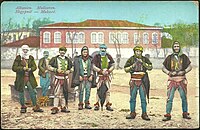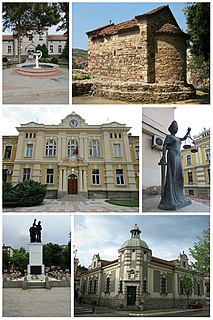
Prokuplje is a city and the administrative center of the Toplica District in southern Serbia. According to 2011 census, the city urban area has a population of 27,333 inhabitants, while the administrative area has 44,419 inhabitants.

Kachaks is a term used for the Albanian bandits active in the late 19th and early 20th century in northern Albania, Montenegro, Kosovo and Macedonia, and later as a term for the militias of Albanian revolutionary organizations against the Kingdom of Serbia (1910–18) Kingdom of Yugoslavia (1918–24), called the "Kaçak movement".

Kuršumlija is a town and municipality located in the Toplica District of the southern Serbia. It is situated near the rivers Toplica, Kosanica and Banjska, southeast of Mount Kopaonik and northwest of Mount Radan. As of 2011, the town has 13,306 inhabitants, while municipality has 19,213.

Medveđa is a town and municipality located in the Jablanica District of southern Serbia. According to the 2011 census, the town has a population of 2,848 inhabitants, while the municipality has 7,438 inhabitants.
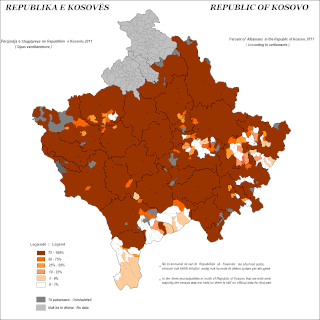
The Albanians of Kosovo, also commonly called Kosovo Albanians, Kosovar Albanians or Kosovars, constitute the largest ethnic group in Kosovo.

Football Club Drita, commonly known as Drita, is a professional football club based in Gjilan, Kosovo. The club plays in the Football Superleague of Kosovo.
Albanians in Serbia are an officially recognized ethnic minority living in the present-day country of Serbia.
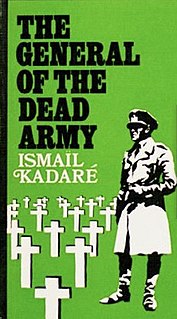
The General of the Dead Army is a 1963 novel by the Albanian writer Ismail Kadare. It is the author's most critically acclaimed novel. Kadare was encouraged to write the book by Drago Siliqi, literary critic and director of the state-owned publishing house Naim Frashëri.
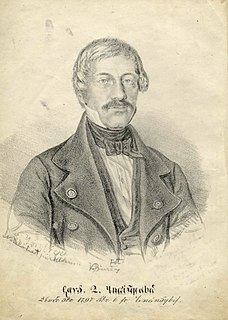
Naum Veqilharxhi was an Albanian lawyer and scholar. In 1844, he created a unique alphabet for the Albanian language using characters he had created himself, the Vithkuqi script. Veqilharxhi is one of the most prominent figures of the early Albanian National Awakening, and is considered by Albanians as its first ideologue.

The Committee for the National Defence of Kosovo was an Albanian organization founded in Shkodër on 1 May 1918. It was mainly consisted of the political exiles from Kosovo and was led by Hoxha Kadri from Pristina. It existed in looser form since May 1915.

The Black Society for Salvation was a secret Albanian nationalist society established in 1909. Its main task was to organize uprisings in southern Albania and Macedonia struggling for the unification of the four Ottoman vilayets with the substantial Albanian population into one autonomous political unit with its own government and parliament. The members of the society considered the armed rebellions as legitimate means for achieving their aims.
The Sanjak of Niš was one of the sanjaks of the Ottoman Empire and its county town was Niš. It was composed of the kazas of Niš (Niş), Pirot (Şehirköy), Leskovac (Leskofça), Vranje (İvranye), Kuršumlija (Kurşunlu), Prokuplje (Ürküp) and Tran (Turan).
Nicholas Dukagjini was an Albanian nobleman of the Dukagjini family in the 15th century. He was the son of Pal Dukagjini, one of the founding members of the League of Lezhë. Nicholas Dukagjini fled to Italy after the second Siege of Shkodra in 1479, but is well known for the return to his homeland two years later, together with Skanderbeg’s son Gjon Kastrioti and other noblemen to lead the armed movement against the Ottomans.
The Neutral Zone of Junik (1921–1923) was a neutral demilitarized border area between the Kingdom of Yugoslavia and the Principality of Albania.

Gashi is an Albanian surname, the name of one of the major historical tribes of northern Albania and historical tribal region situated in the District of Tropojë, or more specifically, the Highlands of Gjakova. The Gashi tribe is known to follow the Kanuni i Malësisë së Madhë, a variant of the Kanun.
KONARE or Komiteti Nacional Revolucionar was a left-wing revolutionary committee of the Albanian political émigrés in Europe, from 1925 till mid-30s. Its central political figure was Bishop Fan Noli.
The Second Congress of Manastir was an Albanian congress held on 2–3 April 1910 in Manastir, back then Ottoman Empire, today's Bitola in the Republic of Macedonia. It dealt with the challenges that the Albanian language and schools faced at the time within the context of the empire, and the platform to overcome them.
